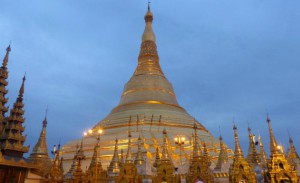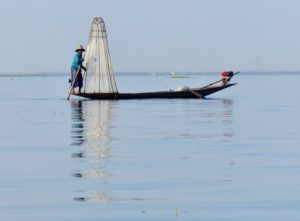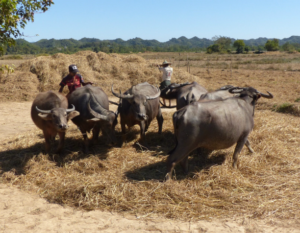By Lynn Hensel, Class of 2010
Larry and I had the privilege of visiting Myanmar this past winter. It is a land of pagodas and Buddha’s images, rice fields and fishing boats, and 135 different tribal groups, each with its own language and culture. Myanmar is the largest country in Southeast Asia, about the size of Texas, and borders Thailand, China, India, Laos, and Bangladesh. There are tall mountains, sandy seashores, fertile valleys, and long rivers, including the Ayeyarwady on which we traveled.
language and culture. Myanmar is the largest country in Southeast Asia, about the size of Texas, and borders Thailand, China, India, Laos, and Bangladesh. There are tall mountains, sandy seashores, fertile valleys, and long rivers, including the Ayeyarwady on which we traveled.
One point of possible confusion is the name. In recent years many westerners referred to it as “Myanmar, formerly known as Burma.” Both names have long been used. When the British annexed Myanmar into their Indian Empire in the late 19th century, they found Myanmar hard to pronounce and adopted Burma as the official name. In 1989 “the Generals”, the repressive ruling regime of the late 20th century, declared Myanmar the official name of the country. Aung San Suu Kyi, the pro-democracy leader and Nobel peace-prize winner, refused to make the change and urged others to continue using Burma. Since the elections of 2011, Suu Kyi softened her stance, suggesting that people use either name.
It’s hard to pick out just a few images from our three-week visit, but for architecture you can hardly beat that of the Intha people who live on Inle Lake, and I mean literally on the lake. They live in stilt villages building homes above the water. The villages have shops, schools, and temples, all accessed by boat. To visit your next-door neighbor, you have to paddle over.
We motored on long-tail boats through the Intha stilt villages. They were endlessly fascinating. The activities of daily living were all on display. Clothes hung on window sills to dry, circular rice cakes dried between bamboo frames, and taro plants draped on rails under houses to dry before shipment to Korea. Men filled the tanks of their boats with fuel from the gas station (pumped by hand from barrels), women washed dishes in the lake, and both bathed — discreetly under their longis — in the lake. You just have to see it; no pictures can truly capture its magic.
The economy is based on fishing—no surprise there—and aquaculture. The Intha make floating farms from masses of water hyacinths and lake silt. They find clumps of water hyacinths that have drifted together, burn off the vegetation, and add silt from the lakebed. These clumps are staked with bamboo poles that allow the gardens to rise or fall with the lake level. They are sturdy enough for a person to walk on them—at least small Asian folks. I stepped out on one and sunk to my knees. Tomatoes are the primary crop of these farms that cover a quarter of the lake.
Fishermen use the traditional methods for fishing. The men pushed their conical baskets to the lake bottom—it’s not very deep—and then repeatedly pumped their three-pronged spears up and down in an effort to skewer a fish. So picturesque! Larry took a record number of pictures.
But what about Myanmar in general? Three aspects stand out for me: the effect of Buddhism, the underdevelopment of the country, and the growth of democracy. So starting with Buddhism. Yes, more than 80% of the population identifies as Buddhist, and there are temples, stupas, and Buddha images on seemingly every corner. But these are only the physical manifestations of the religion. More significant are the ways in which Buddhism permeates the culture of the communities and how the lives of the people and the monks are intertwined. Monks depend on the donations of the generous laity. In turn, the monks minister to the needs of the community. They have stood up to the government on behalf of the people in what is known as the Saffron Revolution. And it may be my imagination, but there was a gentleness that exuded from the places we visited.
Myanmar is terribly underdeveloped. It was like stepping back in time before the advent of mechanization. Much of the countryside is still without electrical power, although the new government has been extending the reach of the electric grid. Outside of the major cities everything was made or done by hand. Not to romanticize it, but it was fascinating to see how ingeniously people coped with the lack of technology.
 This is a place where people still live in homes like those of their ancestors and wear the traditional clothes of their tribes. Even in Yangon, the largest city, most everyone wore longhis. But this won’t last much longer. The younger generation is adopting the tastes and styles of the world culture. The homogenization process has begun.
This is a place where people still live in homes like those of their ancestors and wear the traditional clothes of their tribes. Even in Yangon, the largest city, most everyone wore longhis. But this won’t last much longer. The younger generation is adopting the tastes and styles of the world culture. The homogenization process has begun.
Myanmar suffered for decades at the hands of “the Generals” whose repressive form of socialism kept the country isolated and poor; the annual GDP per capita is only $1700 compared to $52,800 in the US. However, beginning with the mostly rigged election in 2011 and then especially with the mostly open election in 2015, the country has been moving toward democracy. But these are tentative steps. Myanmar is a country of 135 recognized ethnic groups, each speaking a different language and some seeking more autonomy. Civil war continues in several parts of Myanmar. And, of course, there is the military repression of the Rohingya—the Muslims in the Rakhine State.
Outside of the Rakhine State, people were unanimously enthusiastic about the new regime under Aung San Suu Kyi. However, many also expressed concern that the military may again seize complete power. It was a reminder of how fragile a developing democracy can be.
Travel broadens a person’s perspectives, and Myanmar is one of those places that has reminded me of how fortunate I am to have the creature comforts of my life but also that these comforts are not necessary for happiness. In villages we visited where life was very basic, children played joyously and people were content. A good reminder.





Wow! What beautiful photos!! Thank you for sharing.
Thank you, Lynn. After reading your notes I want to visit!
Such a wonderful opportunity. And you really took advantage of it! Bravo!